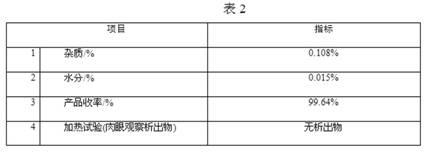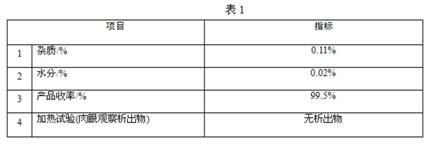Dry degumming method of raw abandoned oil used for producing biodiesel
A technology of biodiesel and degumming method, which is applied in the field of pretreatment and processing of biodiesel raw materials, and achieves the effects of simple operating conditions, reduced product cost, and reduced requirements for filter membranes and operating conditions
- Summary
- Abstract
- Description
- Claims
- Application Information
AI Technical Summary
Problems solved by technology
Method used
Image
Examples
Embodiment 1
[0014] Silicone ∶ white clay=1 ∶ 3 Mix well; activate at 150-200 ℃ for 50-100 min. It is the degumming adsorbent.
[0015] Take 500 Kg of crude waste oil that has been pre-passed through the fence and introduce it into the reactor through the pipeline, heat it to 105 ° C, control the vacuum degree to 0.090 MPa, and stir at a speed of 105 r / min. After 50 min of dehydration under reduced pressure, no bubbles are generated on the surface of the layer; Cool down to 98°C, then add 0.2% compound acid (concentrated phosphoric acid) ∶ Citric acid=2 ∶ 1) After adding the acid, reduce the stirring speed to 50 r / min, the temperature is 100 °C, and react for 70 min. After completion, 1.0% degumming adsorbent by weight of oil was added, and the reaction was continuously stirred for 30 min at a vacuum degree of 0.090 Mpa and a temperature of 120 °C, and the stirring speed was controlled at 40 r / min. The temperature of the raw material is lowered to 90°C, the pressure of the filter pres...
Embodiment 2
[0019] Silicone ∶ white clay=1 ∶ 4 Mix evenly; activate at 150-200 °C for 50-100 min. It is the degumming adsorbent.
[0020] 2.0 tons of crude waste oil that has passed through the fence is introduced into the kettle through the pipeline, heated to 120 ℃, the vacuum degree is controlled to 0.098MPa, and the stirring speed is 100 r / min. After 30 minutes, there is no bumping phenomenon of the material and no bubbles on the surface of the oil layer. Cool down to 97 °C, add a compound acid reagent (concentrated phosphoric acid: citric acid 2:1) with 0.8% of the weight of oil, and then reduce the stirring speed to 60 r / min, the reaction temperature is 110 °C, and the reaction time is 90 min . After completion, 2.0% of the weight of grease was added to the activated degumming adsorbent, the vacuum degree was controlled to 0.098 Mpa, and the temperature was 130 °C under continuous stirring for 60 min, and the stirring speed was controlled at 60 r / min. The temperature was lowered...
Embodiment 3
[0023] Silicone ∶ white clay=1 ∶ 5 Mix well; activate at 150-200 °C for 50-100 min. It is the degumming adsorbent.
[0024] 1000 Kg of pre-filtered crude waste oil is introduced into the kettle through the pipeline, heated to 110-115 ℃, the vacuum degree is controlled at 0.095 MPa, and the stirring speed is 105 r / min. No bubbles were generated. Cool down to 98°C, add 0.6% compound acid reagent (concentrated phosphoric acid: citric acid 2:1) of oil weight, reduce the stirring speed after adding acid, control the stirring speed at 55 r / min, the reaction temperature is 100°C, and the reaction time is 85 min. After completion, degumming adsorbent with an oil weight of 1.5% was added, the vacuum degree was 0.095 Mpa, and the temperature was 120 °C under continuous stirring for 50 min, and the stirring speed was controlled at 60 r / min. The temperature was slightly lowered to 100 °C, and the pressure of the filter press was controlled at 0.45 MPa. Pass through the filter press ...
PUM
 Login to View More
Login to View More Abstract
Description
Claims
Application Information
 Login to View More
Login to View More - R&D
- Intellectual Property
- Life Sciences
- Materials
- Tech Scout
- Unparalleled Data Quality
- Higher Quality Content
- 60% Fewer Hallucinations
Browse by: Latest US Patents, China's latest patents, Technical Efficacy Thesaurus, Application Domain, Technology Topic, Popular Technical Reports.
© 2025 PatSnap. All rights reserved.Legal|Privacy policy|Modern Slavery Act Transparency Statement|Sitemap|About US| Contact US: help@patsnap.com



